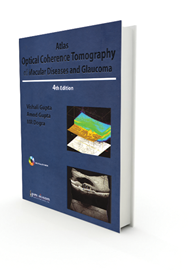The book is divided into three sections: an introduction to optical coherence tomography (OCT), the OCT in macular diseases, and glaucoma. The first section lists the currently commercially available OCT machines, then describes the techniques for acquiring OCT images using the Stratus and Cirrus HD-OCT (CarlZeiss, Meditec,Dublin, CA) and the interpretation of the output, so the majority of OCT images displayed throughout the book are taken using these instruments.
Section 2 presents examples of OCT scans and descriptions of how they are interpreted for macular diseases, ranging from diabetic macula oedema, age-related maculopathy, heredodystrophic disorders, inflammatory retino-choroidal diseases, trauma and postoperative endophthalmitis, to name but a few. This latest edition includes an additional chapter on multi-modal imaging with Spectralis HRA+OCT (Heidelberg,Vista CA) written with the assistance of Reema Bansal. Sushmita Kaushik and SS Pandav have contributed the third section on glaucoma.
Opinions may differ slightly as to the interpretation of some of the OCT images, and the subsequent management strategies, but this should stimulate peer discussion. The chapter on multi-modal imaging reveals the leap in quality of OCT resolution and reference image that is being achieved with this rapidly developing technology, allowing non-invasive access to view the cellular structure of the retina.
The chapter on OCT use in glaucoma shows how detection and monitoring for progression requires both structural and functional evidence upon which to base clinical decisions. Field tests are complementary to OCT. Nerve fibre defects or ganglion cell loss may present earlier but it is important to correlate any OCT defects with visual field changes to make more precise diagnosis. OCT tests being non-subjective may be more consistent than visual field analysis.
The chapters are well organised, introducing the clinical features of a selected condition and the typical OCT characteristics likely to be encountered, followed by a selection of case histories. Each chapter concludes with numbered key messages to take from the presentations and a suggested reading list relevant to the topics covered. The index at the end of the book is brief.
There are exceptional quality colour fundus photographs and fluorescein angiograms accompanying the numerous examples of OCT scans. The chapter on the Spectralis HRA+OCT also includes colour fundus images, but readers should appreciate that an impressive selection of high contrast and quality images are available, some included here, through its dual-beam scanning system of a confocal scanning laser ophthalmoscope (cSLO) alongside the spectral domain OCT.
The only criticism regarding presentation is reserved for the poor quality of some of the automated perimetry printouts that have been included in the chapter on glaucoma.




